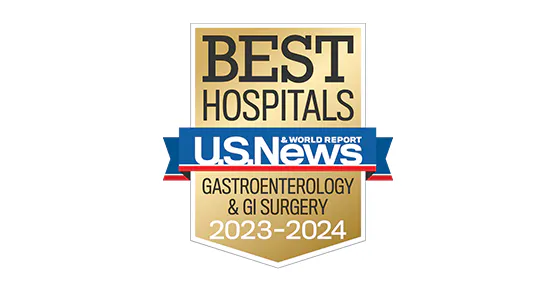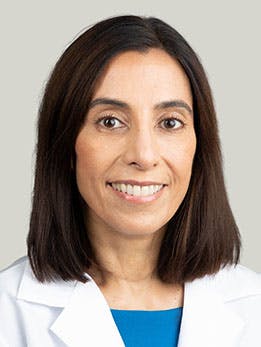Peroral Endoscopic Myotomy (POEM)
Peroral endoscopic myotomy (POEM) is a minimally invasive procedure that uses endoscopic technology to treat digestive and swallowing disorders. For many people, POEM can offer long-term relief from achalasia — a disorder which makes it difficult to swallow and consume food. Unlike traditional surgery, peroral endoscopic myotomy does not require incisions outside the body and offers patients a quick recovery.
The University of Chicago Medicine is one of only a few centers in Illinois offering this advanced technique to patients so they can avoid more invasive surgery. Our interventional gastroenterologists at the University of Chicago Medicine Center for Endoscopic Research and Therapeutics (CERT) are highly skilled at using the latest endoscopy technology to improve the lives of patients suffering from difficult-to-treat digestive disorders.
What is peroral endoscopic myotomy (POEM)?
Peroral endoscopic myotomy is a minimally invasive procedure for achalasia, a rare disorder in which tight muscles in the esophagus prevent food from reaching the stomach and being digested properly.
Our interventional gastroenterologists are experts in performing POEM and other advanced procedures to help ease your symptoms and improve your quality of life.
Who is a good candidate for peroral endoscopic myotomy?
Candidates for POEM include patients with achalasia who may have symptoms such as chest pain, trouble swallowing, coughing, vomiting and weight loss.
At UChicago Medicine, our experts are skilled at handling complex cases of achalasia and helping patients find relief from their symptoms.
How is peroral endoscopic myotomy different from Heller myotomy?
Both the POEM procedure and a Heller myotomy aim to relax muscles in the lower esophageal sphincter that prevent food from moving through your esophagus to your stomach. Research has shown they are both safe and effective for treating achalasia.
However, the treatments use two different approaches. During POEM, an interventional gastroenterologist uses a thin, flexible tube called an endoscope inserted in the mouth, so there are no incisions on the outside of your body. During a Heller myotomy, the surgeon will typically use a laparoscope, which involves making a few small incisions in the chest or abdomen.
Typically, patients who have a Heller myotomy have a longer recovery than those who have had POEM.
Frequently Asked Questions about the Peroral Endoscopic Myotomy (POEM) Procedure
Before POEM, you’ll need several diagnostic tests to make sure you are a candidate. These may include an upper endoscopy to rule out stomach or esophageal cancer and an esophageal manometry study to measure muscle contractions and confirm that you have achalasia. You will also have an esophagram, which will help your doctor understand how your esophagus moves.
Two days before POEM, you’ll need to follow a clear liquid diet.
During the procedure, your doctor will insert an endoscope into your mouth and down your throat to your esophagus. When the endoscope reaches the lower esophageal sphincter, your gastroenterologist will cut the muscle to relax the esophagus so food can pass more easily into your stomach.
Peroral endoscopic myotomy is performed under general anesthesia, so you are not awake during the procedure. After the procedure, you may have some temporary pain in your chest or throat that can be controlled with pain medications.
For many people, POEM offers a quick recovery, no scar and a short hospital stay. What’s more, it can help them eat normally again and significantly improve their quality of life.
But like any procedure, there are risks associated with POEM. Although these are rare, risks include leaks, tears or bleeding in the esophagus.
POEM is not recommended for all patients based on their overall health and medical conditions. For patients who are not candidates for POEM, our specialists may recommend other treatments, such as botulinum toxin injections or a Heller myotomy.
The most common long-term side effect of POEM is heartburn, which can be treated with medication.
Yes, it is possible that symptoms can return after the POEM procedure. If this is the case, another peroral endoscopic myotomy may be recommended.
Recovery from a peroral endoscopic myotomy is typically faster than recovery from a Heller myotomy. If you are like most patients, you will be able to return home the day after your procedure. In general, you can return to normal activities in a few days.
After a peroral endoscopic myotomy, you’ll need to follow a soft diet for about a week. You’ll also need to take medication to reduce your stomach acid. Eventually, you will be able to return to your normal diet.
After you have POEM, you’ll have a checkup with your doctor in one month so we can follow your progress.
Meet Our Peroral Endoscopic Myotomy Specialist

Nationally Ranked in Gastroenterology and GI Surgery
According to U.S. News & World Report's 2023-24 Rankings.
Learn more about U.S. News Best HospitalsEating Again After Achalasia


